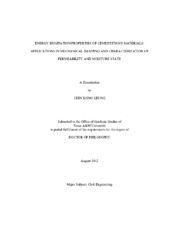| dc.contributor.advisor | Grasley, Zachary C. | |
| dc.creator | Leung, Chin | |
| dc.date.accessioned | 2012-10-19T15:30:22Z | |
| dc.date.accessioned | 2012-10-22T18:02:17Z | |
| dc.date.available | 2014-11-03T19:49:14Z | |
| dc.date.created | 2012-08 | |
| dc.date.issued | 2012-10-19 | |
| dc.date.submitted | August 2012 | |
| dc.identifier.uri | https://hdl.handle.net/1969.1/ETD-TAMU-2012-08-11607 | |
| dc.description.abstract | The study of mechanical energy and electrical energy dissipation in cementitious materials can lead to development of high damping concrete for structural applications, and new non-destructive testing techniques for use on existing concrete structures. This research aims to improve mechanical damping properties of cementitious materials and determine durability parameters from complex permittivity measurements. Damping was improved by utilizing poromechanical effects, and by adding viscoelastic and nanometric inclusions. Poromechanics was utilized to model and predict damping on specimens designed to maximize poromechanical effects, and composite theory was used to predict composite bounds for the loss tangent, i.e. modeling the effects on damping due to the addition of viscoelastic inclusions. Experimental results indicated that substantial damping improvement can be realized by both poromechanical effects and adding novel inclusions into cement pastes. The models were able to predict experimentally measured damping as a function of loading frequency. The electrical energy dissipation in cementitious materials was studied by dielectric spectroscopy as a function of moisture state and pore structure/permeability. The results were compared to predictions from multiphase composite modeling, where the properties of the confined water was inversely determined and used to predict moisture content. It was found that moisture state of cementitious materials has a linear relation to the complex permittivity over a wide variety of frequency ranges. Composite model prediction indicated that permeability of saturated cementitious materials studied in this research is likely dependent on the amount of free water in the pores. Permeability can be inferred from the pore structure of the cement paste via complex permittivity measurements by conditioning cement paste at different levels of relative humidity. | en |
| dc.format.mimetype | application/pdf | |
| dc.language.iso | en_US | |
| dc.subject | Concrete | en |
| dc.subject | Damping | en |
| dc.subject | Cement | en |
| dc.subject | Moisture Content | en |
| dc.subject | Permeability | en |
| dc.subject | GPR | en |
| dc.subject | NDT | en |
| dc.title | Energy Dissipation Properties of Cementitious Materials: Applications in Mechanical Damping and Characterization of Permeability and Moisture State | en |
| dc.type | Thesis | en |
| thesis.degree.department | Civil Engineering | en |
| thesis.degree.discipline | Civil Engineering | en |
| thesis.degree.grantor | Texas A&M University | en |
| thesis.degree.name | Doctor of Philosophy | en |
| thesis.degree.level | Doctoral | en |
| dc.contributor.committeeMember | Lytton, Robert L. | |
| dc.contributor.committeeMember | Hurlebaus, Stefan | |
| dc.contributor.committeeMember | Muliana, Anastasia | |
| dc.contributor.committeeMember | Everett, Mark | |
| dc.type.genre | thesis | en |
| dc.type.material | text | en |
| local.embargo.terms | 2014-10-22 | |


